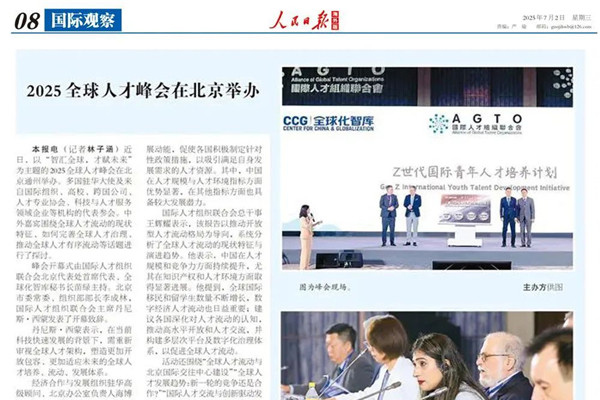-
人民网:中国留学未来发展应关注“留学红利”引进全球人才
人民网12月19日电 由中国社科院社科文献出版社出版、中国与全球化智库(CCG)编写的国际人才蓝皮书《中国留学发展报告(2014)》12月18日在北京发布。根据蓝皮书研究,中国留学未来发展应更关注“留学红利”。 挖掘“留学红利”早已是发达国家重要战略 《中国留学发展报告2014》蓝皮书指出,“留学红利”分为“经济红利”和“人才红利”。在国际社会,“留学红利”早已成为发达国家国家发展战略的一个重要组成部分。在国际留学生中,尤其是来自发展中国家的留学生,很多都是通过政府或私人资助,或者来自经济条件相对优越的家庭。无论从短期还是长期来看,留学生都给其所在学校以及当地政府带来巨额的经济收入。更重要的是,留学生也成为发达国家争夺世界人才红利的重要组成部分。 作为潜在的高技能国际化人才,留学生是目前世界各国政府力争吸引和保留的移民群体,因此,很多国家尽管收紧移民政策,但依然实行较为宽松的留学政策,为留学生毕业后能够留在该国工作提供各种便利。一旦留学生毕业后选择留在当地就业或创业,对当地经济的影响还会更加持久和深远。以美国为例,留学生一直被视为重要的人才储备,尤其是STEM领域的留学生通常是政府青睐的潜在的高技术移民群体。在硅谷,所创业的高科技企业有四成以上来自于外国,而这其中很大一部分都是曾经在美留学的留学生。他们不仅为留学接收国带来源源不断的人力资源和科技创新的动力,而且还为其带来巨额的经济收益。 “留学红利”是我国“人才红利”的重要组成部分 2014年8月21日,国务院总理李克强提出“最大限度释放‘人才’的‘红利’”。中国与全球化智库编写的该蓝皮书指出:“留学红利”是我国“人才红利”的重要组成部分。“留学红利”在我国科教文化、企业创新等领域的重要作用已经明显凸现出来。红杉资本中国基金创始及执行合伙人沈南鹏在“2014第九届中国留学人员创新创业论坛”表达,过去三年里自己所投资的创业企业当中,有1/4的企业家是留学归国人员,这个比例相当高,体现着留学归国人员在创新创业中扮演着重要角色。 树立全球人才观、积极吸引外国留学生 中国与全球化智库(CCG)认为:我国要加大力度吸引留学生回国创新创业,尤其是掌握高科技和专业知识的硕士、博士人才,以扭转人才流失,积攒人才红利。因此,在未来的一段时期内,如何最大程度地发挥留学红利在我国经济社会发展中的战略作用,将是我国留学工作所面临的重要课题之一。 蓝皮书主编王辉耀博士建议,我国要树立“全球人才为我所用”的人才观。善用全球人才是美国发展成功的重要因素。目前在美国市值前50 名的上市公司中,有近一半是移民创建或共同创建。1960~2013 年,美国有72名移民科学家获得诺贝尔奖。党的十八大报告提出建立“具有国际竞争力的人才制度优势”,这要求我国在全球化时代树立起全球人才为我所用的人才观。
2014年12月19日 -
央广网:中国成美国高中留学第一大生源国 在美读中学人数近3万
央广网北京12月18日消息(记者张棉棉)12月18日,由中国社科院社科文献出版社出版、中国与全球化智库(CCG)编写的国际人才蓝皮书《中国留学发展报告(2014)》在北京发布。根据蓝皮书研究,中国高中生赴美留学热潮涌动,在赴美留学大军中数量激增,形成一股显著的力量,并使中国留学发展呈现出明显的“低龄化”趋势:高中生已经成为继研究生、本科生之后的第三大出国留学人群。 2011年中国超过韩国成为美国高中留学生第一大来源国 中国与全球化智库蓝皮书调研合作机构启德教育集团数据显示,自2007~2014 年,加拿大、美国、澳大利亚和英国集中了90%以上的中国高中留学生。其中,加拿大是最受中国高中留学生欢迎的留学目的国,有近三分之一(32%)的中国学生选择在加拿大就读高中。美国、澳大利亚和英国则分别位居第二、第三和第四名。从最受欢迎程度来看,在过去 7 年里,最受男生欢迎的高中留学目的国首先是美国(33%),最受女生欢迎的高中留学目的国首先是加拿大(34%)。 根据《纽约时报》的报道,2007~2012年间,持F-1签证在美国高中留学的人数增长了10倍,达到6.5万人,来自中国和韩国的小留学生位居前两位。 从2009年起,在美就读高中的中国留学生人数直线上升,已在2011年超过韩国成为美国高中留学生第一大生源国。根据美国学生和交流访问学者信息系统(SEVIS)的数据,在美国公立和私立中学中持F-1签证的中国留学生数量10年来增长了60多倍,从2003~2004学年的433人增长到2012~2013学年的26,919人。 中国留学生:抵不住小“常青藤”召唤力 为什么要选择出国读高中?蓝皮书中调查发现原因多种多样。 首先,从教育和考试制度看,国外的学习环境相对自由宽松。一方面,高中生不是凭借高考升学,很多国家的高中生可以凭借高中阶段的成绩申请理想的大学,考核指标相对多元,不仅包括考试成绩,还有平时作业、课堂参与度等;另一方面,很多国家的高中生可以根据个人兴趣爱好和发展方向自由选课,教学也更注重培养社会实践能力和社会参与等。这对于很多希望逃避国内高考竞争和应试教育,尤其希望发展自身特长的学生是重要吸引。 其次,很多高中也是世界名校的摇篮。比如美国东北部的十所高中(Choate Rosemary Hall、Deerfield Academy、The Hill School、The Hotchkiss School、The Lawrenceville School、Loomis Chaffee、St.Paul’s School、Philips Exeter Academy、Philips Academy Andover、The Taft School)被中国人誉为“小常青藤”,就是因为十所学校每年为美国著名高等学府输送大量生源,因此受到小留学生的青睐。很多家长希望将孩子提早送出国也是希望未来入读国外名牌大学可以具有更大的竞争优势。 再次,迅速提高语言能力、培养独立生活的能力等,也是很多家长提早将孩子送到国外就读高中的原因之一。 蓝皮书中的调查发现,教育质量和职业发展是学生和家长选择留学的最主要因素。另外,国内升学压力大、出国留学的就业和移民便利现实因素等也是高中留学生及其家庭考虑的重要因素。 “三高家庭”为赴美高中留学生提供经济动力 是什么样的中国家庭把孩子送到美国读高中?蓝皮书中的调查数据显示,出国读高中和本科的学生家庭普遍呈现出“三高”的特点,即父母至少有一方拥有高学历、高职位和高收入。在近千名受访家长中有七成拥有本科及以上学历,近七成在工作单位中拥有较高的决策权,有六成家庭年收入在 30 万以上。据麦可思针对高中毕业生的调查数据显示,近32%的家长每年为孩子支付的学费在20~30万元,30万以上占23%。 蓝皮书预计未来中国赴美高中留学生将持续增加,基于以下几项因素: 首先,中国的经济发展使越来越多的家庭收入逐年增加,有经济能力支付低龄子女赴美留学的费用。国内教育成本特别是隐性成本数量的增加,已经足以填平本土教育支出和留学支出之间的沟壑了,低龄留学不再是有钱人的专利。 其次,我国高等教育改革进展缓慢,许多家长和学生对国内高等教育现状不满,这直接导致出国读本科的人数不断增加,并进一步向基础教育阶段渗透,这导致了出国留学的高中生人数也在增加。 再次,中国家长对海外大学排名情有独钟,都希望孩子能够进入排名靠前的大学学习。与此同时,家长们发现,与在国内就读高中的学生相比,具有海外高中经历的学生更容易进入知名大学招生视线,这就激发了高中生出国留学的热情。 第四,一些主要留学目的国在政策上都做出了调整,使得留学手续更加便利,更多的学生可以顺利地出国。接收学校也可以通过招收更多中国高中留学生来获得更多资金支持。 第五,高中生的基数大于高等教育阶段本科生和研究生人数,给出国留学人数的增长提供了支持。 第六,在中美留学签证有效期从一年延长至五年,商务和旅游签证有效期延长到十年的政策利好的推动下,中美两国的交流将越来越多,许多家长因工作或进修等原因被派驻美国,其子女也随迁入学,在美国的教育体系下读小学和中学。 中国与全球化智库研究发现,美国高中里留学生的大幅增长也给学校带来了很大的挑战,这其中既包括如何保证每位学生可以接受到高质量的教学,还有如何对这些学生的住宿、学习和生活进行合理的监管。中国学生赴美读高中可以提高自己的语言能力和西方文化知识,为升入美国大学未雨绸缪。但是,低龄留学生因为出国年龄较小,尚未成年,世界观和价值观尚未形成,自我管理能力受限,导致出现了种种问题,如无法按时完成学业、缺少自我保护意识、缺少法律意识、缺少对文明的尊重和了解、难以融入当地社会等,给留学生和家长都造成了不少的困扰。蓝皮书建议留学生和家长在做出留学决定前,能够进行思考,让深思熟虑代替一时冲动,让理性留学代替盲目留学。
2014年12月19日 -
东莞日报:7位市长经济顾问今日为东莞规划作专题咨询
“十三五”时期,东莞将确立怎样的城市发展战略,实现什么样的创新发展?编制好“十三五”规划,对于科学引领下一个五年全市转型升级和科学发展,率先全面建设小康社会具有特别重要的意义。作为一座致力于打造国际化、法治化的城市,东莞亟需了解国内外城市发展的新趋势、新理念,进而为自身发展的“下一个五年”确立新思路、新规划。 “智不备于一人,谋必参诸群士。”今日,我市将召开2014年东莞市长经济顾问专题咨询会,邀请七位市长经济顾问就东莞“十三五”规划的编制和未来发展,作专题咨询,为城市未来发展“问诊”、“把脉”。 7位高参“做客”东莞建言献策 据了解,七位市长经济顾问均是来自经济领域的精英翘楚,参加此次专题咨询会的市长经济顾问包括中国人民银行调查统计司巡视员徐诺金、深圳市企业联合会会长刘应力、国务院参事汤敏、中国与全球化研究中心主任王辉耀、香港工业总会名誉会长钟志平、联华电子有限公司荣誉副董事长宣明智、神州数码控股有限公司董事局主席郭为。 顾问们将围绕“东莞‘十三五’规划”这一主题积极建言献策,并就东莞“十三五”发展战略与城市定位、创新型经济发展、营商环境建设、东莞开放型经济发展等内容进行讨论,以国际视野、战略眼光和前沿思维为我市加快经济社会发展提供科学、专业、权威的意见和建议。 借力“外脑”为东莞发展助力 近年来,东莞一直致力于汇聚社会各界智慧,形成了借力“外脑”问计发展的意识和氛围,进而也提高决策科学化水平,增强东莞高水平崛起的智力支撑。其中一个重大工作创新就是建立了市长经济顾问制度,通过邀请国内外知名专家学者、企业家和杰出人士担任市长经济顾问,以专题调研、专题咨询、顾问年会等多种形式,为我市重大经济决策提供决策参考。 这一制度不仅会提高党委、政府的决策水平与执政能力,也会使决策更加公开化、透明化、民主化,将会为东莞经济社会发展助一臂之力。 使规划更加符合发展规律更加反映人民意愿 “十三五”规划是东莞未来五年发展的纲领性指引文件,市政府专门就这一主题召开顾问咨询会,旨在为东莞“十三五”规划的编制和未来发展提供科学性、前瞻性、专业性和权威性的咨询和建议。 早在今年6月举行的东莞市召开“十三五”规划前期研究工作动员会上,市委副书记、市长袁宝成就指出,“十二五”时期,我市面临转型升级的重任、复杂多变的形势,各级各部门要结合各自工作实际,言透议透,经验要提炼,教训要总结,使“十三五”规划更加适应时代要求,更加符合发展规律,更加反映人民意愿。 袁宝成同时指出,规划编制的过程,也是对过去经验的提炼、教训的反思,最终都要用来指导我们今后的工作实践。“十三五”规划要认真总结“十二五”时期我市经济社会发展的经验、教训,要倾听各方意见,从谏如流,进而提高规划的科学性、前瞻性、专业性和权威性。(高志全)
2014年12月8日 -
南方日报:东莞转型发展“借脑”顶级专家
2014年12月5日,东莞召开2014年市长经济顾问专题咨询会,邀请七位顾问就东莞“十三五”规划的编制和未来发展作专题咨询,为城市未来发展“问诊把脉”。这也是市长经济顾问制度建立以来,顾问们首次以专题咨询会的形式集体亮相。 早在今年6月举行的东莞市“十三五”规划前期研究工作动员会上,市长袁宝成就指出,“十二五”时期,东莞面临转型升级的重任和复杂多变的形势,各级各部门要结合各自的工作实际,言透议透,经验要提炼,教训要总结,使“十三五”规划更加适应时代要求,更加符合发展规律,更加反映人民意愿。 他表示,规划编制的过程,也是对过去经验的提炼、教训的反思,最终都要用来指导今后的工作实践。“十三五”规划要认真总结“十二五”时期东莞经济社会发展的经验、教训,倾听各方意见,从谏如流,进而提高规划的科学性、前瞻性、专业性和权威性。 作为一座致力于打造国际化、法治化的城市,东莞亟须了解国内外城市发展的新趋势、新理念,进而为下一个五年的发展确立新思路、新规划。 此次参加咨询会的7位专家都是来自经济领域的精英,包括中国人民银行调查统计司巡视员徐诺金、深圳市企业联合会会长刘应力、国务院参事/中国与全球化智库副主任汤敏、中国与全球化智库主任王辉耀、香港工业总会名誉会长钟志平、联华电子有限公司荣誉副董事长宣明智、神州数码控股有限公司董事局主席郭为。 顾问们将围绕东莞“十三五”规划的主题建言献策,并就东莞“十三五”的发展战略与城市定位、创新型经济发展、营商环境建设、开放型经济等内容进行讨论,以国际视野、战略眼光和前沿思维为东莞加快经济社会发展提供科学、专业、权威的意见和建议。(记者/段思午 通讯员/张超)
2014年12月8日 -
光明网:打造创客乐园 推动东莞智造
12月3日下午,东莞人才发展论坛与中国(东莞)国际科技合作周同步举行。论坛邀请了一众国内外专家学者,围绕“东莞制造”向“东莞智造”转型升级中人才作用等话题,展开热烈讨论。 论坛上,中国与全球化智库主任王辉耀针对东莞实现高层次人才引进及人才落地等问题提出了建议。他说,东莞首先应扩大东莞市的国际化人才比例,快速形成全国国际人口比例最高的大都市。其次,东莞应实施更便捷的外国人才出入境政策,并出台吸引人才新计划,发展国际合作办学,吸引外国留学生在东莞工作和生活。此外,东莞更应加强海归与本土民营企业对接合作,开展东莞国际人才研究。东莞还应致力于打造成国际人才市场。 中国人事科学研究院原院长王通讯提出,东莞要坚持人才立市、人才兴市、人才大市、人才强市。目标要建设成人才资本丰盈之城、人才构成多元之城、人才流动自由之城、人才创新活跃之城及人才价值实现之城。 王通讯提出,“从长远目标看,‘蓝领东莞’必须变为‘白领东莞’。”他表示,东莞的出路在人才,其灵魂是创新。而留住人才、吸引人才的关键是让人才在这里实现其自身的价值。人才的本质是创新,创新活跃是人才型城市的本质特征。在2009年中国城市竞争力排名榜上,粵港澳总体经济规模,排在全国第一名。而在粵港澳所有城市中,东莞经济规模竞争力、经济效率竞争力方面排名第四。产业成本、产业层次、生活质量几个方面略微靠后。“这说明,在创新人才的育成和引进方面东莞还需进一步努力。” 王通讯认为,东莞要建设人才型城市,离不开对大量创意人才的培养与集聚。“东莞要为形成日益壮大的创意人才阶层而努力奋斗”。创意人才是指工作中包含较多创造性成分的群体,如科学家、工程师、画家、音乐家、设计师、艺术家和娱乐工作者,还包括会计师、医生、律师等白领职业者。他们可以称为“创客”。东莞应该高举“创意经济”的旗帜,成为创客乐园。
2014年12月8日 -
FT中文网:开启中国企业国际化新纪元
——对外投资的新机遇、挑战和建议作者:王辉耀 [FT中文网,2014年12月4日]2014年11月21日至23日,首届“中国企业国际化论坛”于海南三亚成功举行。本次论坛的召开正值中国企业海外投资额有望超过外商对华投资额的历史时刻,引发了社会对于中国企业走出去的讨论,整场论坛吸引了三百多位来自海内外的嘉宾。在论坛上,原中国国家经贸部副部长、亚洲博鳌论坛秘书长、中国与全球化智库主席龙永图讲到,中国经济转型、产业升级需要企业走出去,而世界经济的发展需要中国企业的投资;中国经济国际话语权的提升、强大的外汇储备支持、中国新提出的“一带一路”等互联互通战略载体,更使得中国企业加速走出去成为了必然趋势。中国企业国际化元年正如何开启?在中国企业国际化转型的历史性时刻,中国对外投资的机遇、挑战又在哪里? 一、中国企业迎来国际化新纪元 2014年是中国企业国际化的重要分水岭。随着全球经济形势的好转、中国经济结构调整步伐的加快、对外投资审批政策的全面松绑以及企业国际化经验的长期积累,从对外投资方面看,中国企业的国际化将开启一个新纪元。 在对外投资流量方面, 2013年,中国对外直接投资流量为1078.4亿美元,同比增长22.8% ;2013年,中国接受的外商对华投资流量为1239亿美元,比对外直接投资流量仅多160.6亿美元,如果对外直接投资保持22.8%的增长速度,中国对外直接投资最快有望在2014年首次超过外商对华投资 。根据邓宁的投资阶段理论,当一国人均GDP超过4750美元时,对外直接投资净额明显表现为正值,并呈逐步扩大的趋势,而中国人均GDP已超过6700美元,目前正向资本净流出国转变,这个转变有望在2014年实现。 在国家政策层面,“走出去”是中国从经济发展全局出发做出的重大战略决策,十八届三中全会将“走出去”作为构建开放型经济新体制的重要举措写入《中共中央关于全面深化改革若干重大问题的决定》,国务院于2013年底修改了《政府核准的投资项目目录(2013年本)》,放宽了对外投资审批的限制。2014年10月8日,国务院总理李克强主持召开国务院常务会议,决定再次修订政府核准的投资项目目录,根据修订原则,中国企业的境外投资将全面松绑,除少数另有规定外,境外投资一律实行备案制,这必将极大地促进中国对外投资的发展。 在国际化企业层面,自上世纪80年代开始国际化尤其是“走出去”战略实施以来,中国企业经过多年的市场磨练,已经积累了一定的国际化经验,部分中国企业已经能够以全球视野,整合全球资源,参与甚至主导一些领域的全球价值链,逐渐成长为有核心竞争力的跨国公司。展望未来,全球发展战略已不仅仅是少数最有实力的中国企业领袖们的蓝图,越来越多的中国企业将目光投向世界,在全球市场寻找未来发展的重要机遇和企业发展的全球坐标。 早在2013年底,我们就判断中国将迎来国际化的新纪元,并将中国企业国际化论坛首届年会主题定为“2014:开启新纪元”,随着国家对外投资审批与境外投资监管措施改革的推进,可以说,未来走出去的中国企业将不是数以百计,而是数以千计、数以万计。到那个时候,中国将名副其实地成为对外投资大国,中国的经济外交也必将围绕中国企业对外投资的分布而展开,中国外汇储备的绝对值很有可能也因此而逐步下降,从现在的4万亿美元降到2万多亿美元。 概括而言,在未来几年,中国企业国际化将面临如下新机遇。 (一)欧美发达国家经济复苏步伐加快,全球投资企稳回升,为中国企业国际化提供了有利的外部环境。 2013~2014年,世界经济继续温和复苏,欧美等发达国家经济增长动力明显增强,经济形势进一步好转。与此同时,受美国金融危机以及欧债危机的持续影响,近年来,世界经济结构正发生深刻变化,新技术、新产业与新商机层出不穷。在全球经济特别是欧美发达国家经济复苏与世界经济结构调整的大背景下,全球投资企稳回升。根据联合国贸易与发展会议(UNCTAD)的数据,2013年,全球对外直接投资流入规模呈恢复性增长,流入量从2012年的1.33万亿美元上升到1.45万亿美元,同比增长9%。根据UNCTAD《世界投资报告2014》的预测,世界投资将进一步增长,2014年全球对外直接投资流量预期会达到1.6万亿美元 。良好的全球经济复苏势头与企稳回升的投资形势为中国企业国际化创造了有利的外部环境,必将促进中国企业国际化发展。 (二)中国经济持续稳定增长,经济结构调整与转型升级取得新进展,为中国企业国际化提供了强劲的内部支撑。 在全球经济复苏大背景下,中国经济持续稳定增长,经济结构调整与转型升级取得新的进展,经济增长的内生动力不断增强。2013年,中国GDP总量达到9.18万亿美元,外汇储备在2013年增加了逾5000亿美元,余额累计近4万亿美元 ,与此同时,人民币国际化持续推进,2013年跨境贸易人民币结算累计达4.63万亿元,同比增长57%。企稳的经济、巨额的外汇储备以及日益国际化的人民币为中国企业的国际化发展提供了强劲的支撑。 (三)“走出去”成为深化改革构建开放型经济新体制的重要举措,为中国企业国际化指明了战略方向。 党的十八大报告提出,要“加快走出去步伐”,增强企业国际化经营能力,培育一批世界水平的跨国公司。十八届三中全会将“走出去”作为构建开放型经济新体制的重要举措之一列入了《中共中央关于全面深化改革若干重大问题的决定》,决定进一步明确了“走出去”的发展战略,鼓励企业及个人扩大对外直接投资,允许自担风险到各国各地区自由承揽工程和劳务合作项目,允许创新方式走出去开展绿地投资、并购投资、证券投资、联合投资。这为中国企业与个人对外直接投资指明了发展方向,将进一步促进中国企业国际化发展的加速。 (四)对外直接投资审批与管理制度改革加快,进一步消除了中国企业国际化的审批障碍。 2014年,国家发改委与商务部等部门根据国务院《政府核准的投资项目目录(2013年本)》,对投资审批权限进行了削减。2014年5月,发改委颁布了《境外投资项目核准和备案管理办法》,该办法提高了境外投资项目的核准权限、缩小了核准范围,非限制性行业与限制性国家10亿美元以下的投资项目一律实行备案制。同时,该办法简化了审批程序,明确了审批时限,提升了境外投资项目核准和备案的规范化、便利化水平。商务部新修订并于2014年9月5日发布的《境外投资管理办法》在三个方面进行了改革:确立企业对外投资主体地位, 企业开展境外投资的经济技术可行性由其自行负责,除了涉及敏感地区和敏感行业的情况之外,其他企业境外投资全部实行3个工作日之内的备案制;取消了特殊目的公司与并购类境外投资的核准要求,不再需要提交《境外并购事项前期报告表》(也即通常所说的“小路条”);专设章节增加了对于环境保护和企业文化建设的指导性意见,更加注重事后管理和企业引导。发改委以及商务部有关对外投资审批的放宽以及监管措施的改革必将进一步促进中国企业的对外投资,在更加清晰的政策法规框架下及各级政府部门的大力支持下,中国企业的国际化必将迎来一个全新的发展阶段。2014年10月8日,国务院常务会议决定再次修订政府核准的投资项目目录,除少数另有规定外,境外投资一律实行备案制,新修订的目录实施后将极大地促进中国企业的对外投资。 (五)中国企业已积累了一定的国际化经验,具备了大规模国际化的条件与能力。 中国企业经过多年的市场磨炼,已经具备了“走出去”的条件与能力。从中国企业整体看,中国企业过去对外直接投资热衷能源资源的传统驱动形式正在发生转变,目前逐步形成了能源资源驱动、市场驱动、技术驱动等多种投资驱动格局,越来越多的中国企业涉足国外高科技领域投资,追求高附加值投资。部分中国企业在对外投资策略、操作财技、风险防范及跨文化整合方面已积累了一定的经验,为其他企业提供了借鉴。 (六)“一带一路”战略的提出为中国企业提供了海外拓展的新机会。 2013年9月与10月,中国国家主席习近平在访问中亚四国与印度尼西亚时分别提出建设“新丝绸之路经济带”和“21世纪海上丝绸之路”的战略构想,强调相关各国要打造互利共赢的“利益共同体”和共同发展繁荣的“命运共同体”。 “一带一路”战略构想对有意进一步开拓海外市场的中国企业提供了新的历史机遇。 二、中国企业国际化的挑战 (一)部分企业国际化战略不清晰,谋划不足 国际化是企业发展的长期趋势,在企业的不同发展阶段,企业是否需要“走出去”以及何时“走出去”进行国际化也没有肯定的标准答案。对于中国企业来说,在决定是否要以及什么时候把步子迈向海外前,首先要解决自身的战略布局问题:未来若干年,企业所处行业在全球范围内有哪些主要发展趋势?这些趋势性变化有哪些是需要通过国际化手段来解决和追赶?未来的机会与挑战有哪些?全球市场格局会产生怎样的变化?有的企业认识不明确、战略不清晰,造成国际化盲动,一些项目匆忙决策,有的竞购项目不惜抬高成本,导致收购后财务压力巨大,企业经营困难。 全球产业格局与趋势始终是一个动态的过程,企业需要根据自身的行业以及企业所处的行业与市场地位进行分析评估,决定企业是否以及何时国际化,并制定可操作的国际化战略,谋定而后动。 (二)风险防范意识有待进一步增强 企业国际化是一个复杂长期的过程,中国企业国际化起步晚、经验不足,大多数中国企业对国际化过程中可能产生的风险虽有意识,但防范措施不力,尤其是政治风险与法律风险,已成为中国企业国际化面临的主要风险。2014年5月,越南发生主要针对中资企业及华人的暴力打砸抢烧事件,在越南平阳等省的中资企业损失惨重。此外,伴随着肇始于突尼斯的民主化浪潮,此前曾被认为中国具有政治地缘优势的一些发展中国家正转化为高风险地区,使中国企业在该国区的投资不确定性增加。 法律风险是除政治风险外中国企业对外直接投资面临的另一大风险。由于不同的国家针对外国直接投资的政策和法律不同,在国家安全、反垄断、环境保护、劳工、税务以及行业限制等方面都有不同的规定。另外,不同国家有关投资的相关政策与法律经常会因为外部经济环境的变化而进行调整,给进入东道国的企业增加了潜在的投资风险。同时,由于中国企业国际化尚处于起步阶段,不少企业对国外法律不熟悉,在守法方面要求不严格,面临较大的法律挑战。 (三)中小企业对外直接投资融资渠道狭窄,融资成本较高 据中国与全球化智库和中国国际经济合作学会的调查,目前对外直接投资企业的融资出现了分化,大型国有企业及大型私营企业由于多为上市企业,资本市场是其对外直接投资资金的主要来源。同时,商业银行贷款、政策性银行贷款以及并购贷款等专项贷款也主要在向大型国有企业倾斜。而中小企业在国际化运营方面,融资普遍困难。中小企业融资难的另一个问题是融资成本偏高,导致企业在国际投资过程中缺乏竞争力。 (四)部分企业在对外直接投资过程中缺乏合作 近年来,越来越多的中国企业开始参与国际竞争,伴随中国企业走出国门,国内企业的竞争也蔓延到海外。在非洲、拉美、东南亚国家或地区,在基础设施领域的电站、大坝以及公路铁路等项目,经常出现几家中国企业同时竞标,有的企业为了拿到订单,采取低价策略,不断降价,造成恶性竞争。有的企业在拿到项目以后,为了降低成本又偷工减料,降低工程质量,导致合同最终无法履行,给企业自身造成很大的损失,同时损害了中国企业在海外市场的整体形象。 (五)中国对外直接投资企业国际化程度还较低 中国与全球化智库在大量中国走出去企业案例研究的基础上,构建了“中国企业国际化评价体系”,将投资效率、海外人才、海外市场、社会责任以及产业链并购等方式作为指标纳入企业国际化程度评价,根据中国与全球化智库从公开资料收集的数据分析,中国企业的国际化程度普遍不高,根据各指标权重计算得出的分数相对较低。而中国企业联合会和中国企业协会于2013年根据企业海外营业收入、海外资产和海外员工占企业总数的比例计算出的中国100大跨国公司平均跨国指数为12.93%,这一数值不仅远远低于世界100大跨国公司跨国指数62.25%的平均水平,而且远远低于发展中国家100大跨国公司跨国指数38.95 %的平均水平,这充分说明中国企业跨国经营水平还有待进一步提高。 企业国际化的一个重要标志是人才的国际化,分析中国非金融类对外直接投资企业在海外分/子公司的员工构成与聘用机制,我们发现中资海外公司员工国际化程度、管理层国际化程度、董事会国际化程度都普遍较低,海外公司雇员以国内员工外派为主,外籍雇员主要来自发展中国家,离实现对外直接投资雇员本土化还有较大差距。人才是企业国际化的核心竞争力,目前来看,无论是中国企业内部的国际化人才比例还是海外分/子公司国际雇员的比例,都有较大提升空间。 (六)国际化专业中介服务机构的力量没有得到充分利用 对外直接投资的中介服务机构大致可分两大类:一是专门性中介服务机构,如会计师事务所、律师事务所、资产评估公司等;二是一般性中介服务机构,如投资顾问公司、财务咨询公司、财经公关公司以及管理咨询公司等。对外直接投资中介服务机构在中国企业国际化进程中有非常重要的作用,它有广泛的信息来源,可以减少对外直接投资中的信息不对称,降低对外直接投资的风险;同时中介机构专业能力精熟,通过中介服务机构的前期尽职调查,可以为对外直接投资企业提供科学、可行的评估,明辨法律财务等风险,帮助企业进行科学合理的投资决策,提高国际化运作效率。由于外资品牌投资中介机构服务费用较高,部分企业为节省投资成本,放弃聘请有丰富经验的国际化投资服务机构,结果因专业经验欠缺及项目尽调不充分方案设计有遗漏等原因导致交易后隐藏的矛盾暴露,有的甚至影响到项目正常运营下去。部分本土对外直接投资中介机构虽然收费较低,但有的中介服务机构的服务水平达不到国际水准。因此对中国“走出去”的企业而言,目前还是需要充分信任并利用国际化的专业中介服务机构的力量,组成国际与国内中介服务机构相结合的顾问团队,实施对外直接投资。 (七)应付处理东道国复杂政治社会关系的能力有待提高 中国企业在发展中国家的对外直接投资中面临较多复杂的社会政治关系挑战,有的国家各种力量长期博弈对峙,中国对外直接投资企业由于没有处理好与各派系的关系,有的项目遭遇派系力量的阻挠导致失败。据我们的调查,中国一部分对外直接投资企业在平衡东道国各种关系上存在较严重的误区,这主要表现在三个方面:一是过度依赖东道国政府高层关系,有的国家政府自身并不稳定,中国企业过分依赖这种不稳定政府的高层官员,容易导致低层普通民众的反对,甚至可能引发抗议事件,最终导致项目实施不下去;二是不重视反对派、NGO组织以及媒体的声音,尤其是NGO。在普选国家,NGO组织和媒体力量强大,往往能掌握舆论的话语权,中国企业在对外直接投资过程中往往轻视这些力量,使一些原本有更好解决方式的环境社会矛盾激化,进而影响投资项目。三是在履行企业社会责任上有的还有欠缺,企业社会责任的核心是民本,企业在国际化运营过程中,应通过项目带动社区经济的增长,同时要重视社区居民的就业,实现与东道国社区的共同发展,与居民和谐共处。 (八)跨文化整合能力较弱 当今世界,以美国为首的西方文化、以中国传统儒学为代表的东方文化、以伊斯兰教为特征的伊斯兰文化以及印度文化、俄罗斯文化、拉美文化等主要文化类型并立交错、差异鲜明,形成了当今世界性与民族性共生、全球化与多样化并存的文化格局。世界文化的多元性造成了各国文化的差异性,走出去的中国企业由于与东道国的语言、风俗习惯、思维方式、价值取向以及宗教信仰等方面的差异给企业对外直接投资带来的不确定性影响巨大。另一方面,东西方文化差异以及由此带来的商业文化差异给企业投资和收购兼并后的整合工作带来困难。据我们的调查,东道国文化包容性越弱的国家投资并购后的整合风险越大,这类国家及居住企业文化兼容性差;而东道国文化包容性越强的国家投资并购后的整合风险越小,这类国家及居住企业容易接受收购投资方带来的企业文化。中国企业对外直接投资应以尊重东道国的文化习俗为出发点,在考虑公司的整体利益的原则下努力化解这些文化差异带来的不确定风险。 三、中国企业国际化的建议 (一)加快对外直接投资立法 自2000年中央和国家提出“走出去”战略之后,国务院、国家发改委、商务部以及国家外汇管理局等部委都先后制定了对外直接投资的政策,并出台了相关实施意见。这些政策规章对促进与规范中国对外直接投资发挥了重要作用。但随着国际经济环境的变化,中国企业国际化进程的加快,有的政策与规章已不能适应中国对外直接投资快速发展的形势,而有的政策措施也需要进一步向法律条文演进,以更好地推动中国企业的对外直接投资。因此,我们认为,国家应加快制定并实施《对外直接投资法》,作为统一调整中国对外直接投资关系的基本法律,通过该法对中国企业国际化过程中涉及的投资主体、投资形式、审批程序、融资税收政策、管理部门及职能监管、中介服务机构与争端解决等做原则性的规定,确保中国对外直接投资有法可依。 (二)加大对外直接投资财税金融支持力度 目前,中国在对外直接投资方面,配套的财税金融制度、政策体系建设虽取得很大进步,但在财税、金融、民营企业融资等方面尚存不足。 首先,在财税方面,应加大能源、资源、高新技术产业等行业对外直接投资的财税政策支持力度,完善对外直接投资企业所得税制度,加大重点行业对外直接投资税收优惠力度并细化税收优惠政策,完善对外直接投资的税收征管措施。 其次,在金融方面,加快国内金融改革步伐,建立多层次资本市场,支持对外直接投资企业通过发行股票、债券等多元方式融资,为企业对外直接投资提供广泛的资金来源。积极推动银企合作,建立以中小企业服务为核心的多层次对外直接投资担保体系,允许对外直接投资企业以项目本身权益做担保,扩大银行等金融机构对中小企业尤其是民营企业的支持范围。 并且,扩大设立面向特定国家和地区以及特定产业的对外直接投资引导基金,改善中小企业尤其是民营企业的融资环境,鼓励社会资金设立对外直接投资并购基金,加强对中小企业尤其是民营企业的金融支持。 再次,推进人民币国际化进程,加强亚洲货币合作,实现人民币在亚洲的区域化,建立人民币离岸金融市场,推动人民币参与国际结算,扩大人民币国际化范围,同时放松外汇管制,促进中国对外直接投资的便利化。 最后,推动银行等金融机构对外直接投资并购,建立分支网点,配合企业国际化,鼓励对外直接投资企业借助海外市场通过项目融资的方式进行融资。 (三)提升企业国际化经营能力 中国企业在国际化发展过程中获得了一些卓越的成功经验,但从总体分析,中国企业国际化还存在较多问题。企业国际化应战略性布局,优化企业制度,提升合规运营能力,增强合作意识,履行社会责任。 战略方面,企业应高度重视并认真制定国际化经营战略,前期调研要充分,战略方案要细化,决策过程要科学,制定的战略具有可持续发展性。 在企业制度上,应规范公司治理结构,使企业建立适应国际市场规则、守法高效、财务合理的制度体系,建立对外直接投资项目的管理、监控、考核和激励机制,对海外子公司充分授权,大力推进管理与运行的本地化,正确处理国内母公司与海外子公司的关系。 履行企业社会责任,提升企业的国际形象。尊重东道国法律、文化与习俗,保护投资地环境。加强与东道国投资地社区与居民的友好沟通,积极参与当地社区的活动,积极参与东道国与企业有关的慈善活动,构建具有企业特色的社会责任体系。充分利用东道国的各类媒体,做好企业形象宣传。 (四)加强合作,联合国内外企业共同进行国际投资 在对外直接投资上,中国企业应树立互利共赢的观念,加强与国内外企业及机构的合作。首先,在对外直接投资过程中,加强与东道国本土企业的合作,成立合资企业共同运营。在中国改革开放之初,国外企业在中国进行投资,绝大多数即采用与中国企业合资的形式,中国企业走出去新到一国投资,可借鉴以前国外企业到中国投资的方式;其次,在对外直接投资过程中,加强国内企业间的合作,实现信息共享与优势互补,避免国内企业在国外投资过程中出现无序恶性竞争,导致几败俱伤的情况;再次,在对外直接投资过程中,加强与国际领先企业的合作,联合国际优秀企业共同进行投资,既可学习国外优秀企业跨国投资管理的经验,又可分散降低对外直接投资风险;此外,在对外直接投资过程中,加强与银行及投资基金等金融机构合作,组建财团进行对外直接投资,实现产业资本和金融资本的联合和渗透;同时,在对外直接投资过程中,还应重视与当地非政府组织的联系与合作,积极加入东道国相关行业协会组织,要善于变通,通过合作共赢取得更广泛的支持。 (五)推动本土对外直接投资服务机构发展 国际投资中介服务机构在跨国投资并购领域具有丰富的实践经验,中国企业对外直接投资应充分依托国际中介机构的力量,提高对外直接投资的效率。在充分依托国际中介机构提升中国企业对外直接投资效率的同时,应加大力度支持本土对外直接投资中介机构的发展。同时,建立并完善与企业国际化相适应的对外直接投资中介服务机构法律保障体系,引导本土对外直接投资中介服务机构的发展,促进外资中介服务机构的规范。要建立以行业自律为主与政府监管相结合的监管体系,督促行业协会根据国际规则制定标准化的对外直接投资中介服务程序,建立规范的执业规则与管理制度,提高中介机构服务质量。加强对投资服务中介机构执业人员的职业道德教育和诚信教育,强化中介服务机构在对外直接投资过程中的责任,建立对外直接投资中介服务机构黑名单制度,对进入黑名单的中介服务机构进行业务限制。 (六)建立多方合作的风险防控体系 近年,国际经济政治形势日趋复杂,随着中国对外直接投资规模的不断扩大,面临的各类风险也越来越多,除传统经营风险外,政治风险与法律风险成为高发风险,对中国企业国际化产生重要影响。在风险防范方面,应建立政府、企业与第三方合作的风险防控体系,实现三方信息共享。 政府层面。应完善对外直接投资立法与保障制度,尽快制定《对外直接投资保险法》,在健全法制的同时,建立专门的对外直接投资保险机构,设立对外直接投资救急基金。与更多的国家签订双边投资保护协定。加强安全监管,建立中国企业对外直接投资风险评估体系,完善对外直接投资合作境外安全风险预警和信息通报制度,建立常态化的境外风险应急救助机制。在信息服务方面,改进信息服务及发布方式,通过国家驻外使领馆及企业等机构,为中国企业提供投资信息。同时,在外交上,应进一步完善中国的领事保护制度,切实保护境外中国公民和企业的安全与利益。此外,还应为民间智库及其他机构开展企业国际化研究提供便利,通过各种形式支持民间智库对企业国际化的研究。 企业层面。建立风险防控机制,进行风险预测、预防和控制。一是要健全治理结构,加强内部监管,合规运营;二是要借鉴国际风险管理经验,准确科学地发现、识别、防范、控制和化解经营风险。 发挥第三方机构作用加大风险识别。利用行业协会以及智库等相关研究机构的专业研究力量,加大对外直接投资风险研究,定期发布相关风险信息,为企业选择投资项目、合作伙伴和制定国际化经营战略提供决策咨询。 (七)建立企业国际化人才支持体系,实施更加开放的人才政策 近年,中国积极参与国际人才竞争,制定了《国家中长期人才发展规划纲要(2010~2020年)》,确立人才优先发展战略布局。由于中国企业国际化是一个全新的课题,全球经济的新形势对人才素质也提出了新的要求。但总体看,目前中国的国际化精英人才依然短缺,这也是导致企业对外直接投资失败、跨国经营能力低下的最大因素。根据2008年在博鳌论坛上麦肯锡的调查数据显示,88%的企业高管认为缺乏人才是海外并购难以成功的首要原因。埃森哲管理咨询公司2010年发布的《中国企业全球化之路》报告也指出,中国企业国际化面临的主要困难之一就是缺乏国际化人才:缺乏外语流利、商务精通、专业深厚、经验丰富、熟悉财务法律的复合型国际经营管理人才。国际化人才也是影响中国企业对外直接投资经营能否成功的关键因素。加快建立国际化精英人才支持体系成为当务之急。 首先,国际化精英人才是企业对外直接投资的智力保障,应坚持把培养国际化精英人才作为国家“人才战略”的重要组成部分,建立并优化多层次国际精英人才培育体系。 其次,实施更加开放的人才政策,充分发挥中国海外华侨华人专业人士的作用为企业国际化服务。根据中国社会科学院社科文献出版社《海外华侨华人专业人士报告(2014)》,中国在海外有400多万专业人才。这些人士大多既了解中国企业的情况,又熟悉当地的政策环境,是中国企业海外投资运营管理不可多得的财富。 再次,充分利用海归人才的力量为中国企业国际化服务。根据中国社会科学院社科文献出版社《中国海归发展报告(2014)》,中国每年有30多万海外学成归国人员。这些人员熟悉外语,了解留学国的文化环境,对中国企业与运营也有一定了解,同时还具备专业知识与技能。中国企业国际化应充分利用好海归人才的力量。 第四,政府设立国际化精英人才培养专项基金,支持企业利用市场渠道培养懂金融投资,通外语商务,熟财会法律的国际化精英人才,支持企业在实践中锻炼培养精英人才。 第五,打造有吸引力的文化制度环境,简化出入境手续。根据我们的了解,华为目前有3万多名员工在国外工作,联想也有三成多的员工在海外 ,因签证等原因,员工进出国门不方便,对公司运营造成一定影响。中国急需简化签证申办手续,增加免签国数量,延长停留时间,优化通关手续,在签证、社会保障及居留等方面提供便利。另外,还可以为人才提供良好的工作氛围,为企业的国际化精英人才的招聘提供优质服务。 结语 自“走出去”战略提出以来,在经济全球化发展的推动下,特别是随着中国综合实力的提高,中国企业对外投资提速,中国企业的国际化进程不断加快,这对推动中国经济的转型升级,拓展中国经济发展空间、提高国际竞争力水平、促进可持续发展进程发挥了重要作用。我们高兴地看到,通过实践磨练,部分中国企业已经能够以全球视野,整合全球资源,参与甚至主导一些领域的全球价值链,逐渐成长为有核心竞争力的跨国公司。培养和打造更多的来自中国的跨国公司,将大大扩大和深化中国参与全球化的程度,从而使中国经济成为经济全球化的主流。 参考文献: 1.谈萧,《中国“走出去”发展战略》,中国社会科学出版社(2003年出版) 2.陈春花、刘晓英,《企业并购中的文化整合》,中外管理(2005), (5), 38-40. 3.刘大卫,《企业并购中的人力资源整合研究》,华东师范大学学报 (2006) 5(6). 4.王志乐,《走向世界的中国跨国公司》,中国商业出版社(2004年出版) 5.蓝庆新、夏占友,《中国企业“走出去”》,对外经济贸易大学出版社(2007年出版) 6.黄孟复,《中国民营企业“走出去”状况调查》,中国财政经济出版社(2009年出版) 7.王辉耀,《中国模式——海外看中国崛起》,凤凰出版社(2010年出版) 8.王辉耀,《中国海外发展——海外看中国企业“走出去”》,东方出版社(2011年出版) 9.顾露露, Reed, R. (2011). 中国企业海外并购失败了吗?[J]. 经济研究, 7, 116-129. 10.冯雷等著,《中国“走出去”方式创新研究》,社会科学文献出版社(2011年出版) 11.王辉耀,"Ten Chinese going global models: emerging patterns and analysis, The European Journal of Finance," DOI:10.1080 /1351847X.2012.671786 12.裴长洪,《中国海外投资促进体系研究》,社会科学文献出版社(2012年出版) 13.张海燕,《走出去——民营企业境外投资操作指南》,浙江工商大学出版社(2012年出版) 14.白远,《中国企业对外直接投资风险论》,中国金融出版社,(2012年出版) 15.魏建国,《“走出去”战略100问》 ,中国商务出版社(2014年出版) 16.陈柏福,《我国文化产业“走出去”发展研究——基于文化产品和服务的国际贸易视角》,厦门大学出版社(2014年出版)
2014年12月8日 -
澎湃新闻:民营企业走出去可更有效减少“中国威胁论”
“2014年后,中国会迎来对外投资的黄金时代30年。未来,中国的民营企业将会成为走出去的主力,占40%以上”,中国与全球化智库(CCG)主任王辉耀在接受澎湃新闻专访时说。 上个世纪90年代中期开始,中国经济进入转型期,由卖方市场向买方市场转变,标志着我国国内市场出现结构性饱和,通过“走出去”扩大海外市场、转移产能,成为市场发展的必然选择。在竞争日益激烈的市场中,企业的利润率降低,为寻求企业的持续发展,需要开拓国际市场,以寻找不断发展壮大的支撑。 在最近由中国与全球化智库(CCG)等机构举办的“中国企业国际化论坛” 上,澎湃新闻发现,除了官员、各大央企代表、大型民营企业家和学者参会之外,还有不少中小型民营企业家与会,他们当中有不少人能用比较流利的英语与外国学者和企业家侃侃而谈。 “民营企业家,特别是中小型民营企业家,他们的投资需求很旺盛。这从他们参会的高涨热情中能看出来,他们踊跃参与各个美国、欧洲、非洲等区域的投资分论坛,咨询各类政策信息、为企业寻找合适的走出去人才。”王辉耀告诉澎湃新闻。 “中国与全球化智库(CCG)”是由中国国际人才专业委员会(国家民政部批准)、中国与全球化研究中心和南方国际人才研究院及北方国际人才研究院所组成。该智库每年出版企业国际化蓝皮书《中国企业国际化报告》。 在采访中,王辉耀表达了他对中国民营企业走出去的看法: 第一,未来,中国民营企业会成为中国企业走出去的主力。目前,中国民营企业已占对外直接投资比例的44%。 第二,中国民营企业在走出去过程中面临三大主要挑战:复杂审批程序的简化,获得投资地政府的支持;中小企业走出去的融资问题和增强走出去企业的合作。 第三,民营企业走出去是检验中国经济真正实力的标准之一。 【对话】 澎湃新闻:中国民营企业走出去现状如何? 王辉耀:近年来,中国民营企业在对外直接投资上表现出浓厚的兴趣和极大的积极性,民营企业在对外直接投资流量的占比不断增加,民营企业日益成为中国企业海外并购的生力军。尤其在美国市场,民营企业的投资总额占中国对美投资总额的76%,民营企业在美投资项目总数已占中国对美投资项目总数的90%。国有企业在中国企业对外直接投资中占比不断下降,根据商务部等统计资料,工商登记注册为“国有”性质的企业对外直接投资比例已降至55.6%。 中国对外直接投资审批手续的简化以及对外直接投资便利化措施的推出,民营企业的对外直接投资活力将得到进一步激发。与此同时,国有企业和民营企业在境外并购中扬长避短、携手合作的案例也越来越多。 澎湃新闻:民营企业走出去的未来发展趋势? 王辉耀:过去,中国是以国有企业为主的初期的主导形式,现在变成了国营企业和民营企业并驾齐驱的模式。从数据统计来看,民营企业出去的势头更猛,效果可能更好,收益可能更大。 从整个中国企业国际化历程的大趋势来看,中国民间的外投资现在还没有成为中国对外投资的主体,但无论从存量投资规模还是当年流量来看,还是从发展的速度来看,民间投资的速度增长非常快,有可能在明年和后年成为中国对外投资最主要的主力。 澎湃新闻:您觉得民营企业家在这次论坛上表现出哪些比较迫切的需求?他们希望能解决哪些问题?中国民营企业在“走出去”过程中还有哪些阻力和挑战? 王辉耀:我感觉与会企业家最希望解决这么几个问题: 一是简化审批程序和复杂手续,更好地获得投资地政府的支持。 现在,中国政府对中国企业走出去、海外投资持开放态度,鼓励支持民营企业、国有企业共同走出去开拓国际市场,所以将会形成一系列的支持政策。 最近我国出台了关于中国企业对外投资的有关规定和法律,就从制度层面上来保证走出去。以前每个企业投资都需要报案、审批,现在除特殊投资项目需要审批以外,大部分采用备案制。现在,我们有退休的驻外使领馆官员继续发挥余热,更好地帮助中国企业对接与投资地国家的支持,帮助国家走出去。 二是解决中小企业融资问题。 中小企业面临着对外直接投资融资渠道狭窄,融资成本较高的问题。根据我们发布的企业国际化蓝皮书《中国企业国际化报告(2014)》,综合中国国际贸易促进委员会发布的中国企业“走出去”调查数据,有近30%的企业对目前对外直接投资的融资支持服务非常不满意,68.4%的受访企业希望政府提供融资支持。 同时,对外直接投资企业的融资出现了分化,大型国有企业及大型私有企业由于多为上市企业,资本市场是其对外直接投资资金的主要来源。商业银行贷款、政策性银行贷款以及并购贷款等专项贷款,也主要向大型国有企业倾斜。中小企业在国际化运营方面,融资普遍困难。中小企业融资难的另一个问题是融资成本偏高,这导致企业在国际融资过程中缺乏竞争力。 三是寻求如何更好地增强企业间合作。 部分中国企业在对外直接投资过程中缺乏合作,一些中小型民营企业单枪匹马地走出去,他们希望能拓展上下游产业链。与此同时,在一些项目上,经常出现中国企业同时竞标,有的企业为了拿到订单,采取低价战略,造成恶性竞争。有的企业在拿到项目之后,为降低成本,偷工减料,导致合同无法履行,给企业自身造成很大损失,同时也损害了中国企业在海外市场的整体形象。 澎湃新闻:您刚提到中小企业融资难,那么中小企业资金来源主要包括哪些? 王辉耀:根据我们做的调查,中小企业资金来源主要集中在:一是企业自有资金:约56.6%的受调查企业通过自有资金进行对外直接投资,但因资金规模小、风险承受能力低,中小企业难以在国外进行持续运营。 二是国内金融机构及其境外分支机构的信贷支持,由于中小企业规模实力有限,能获得金融机构撑起大量信贷支持的偏少,仅17.39%的受调查企业通过国有银行金融机构获得对外直接投资资金。 三是资本市场直接融资,14.3%的受调查企业对外直接投资资金来自资本市场。 澎湃新闻:中国民营企业走出去,将会对中国和世界产生何种影响? 王辉耀:从国内角度看,中国有大量外汇储备,需为富余资金找出路,对外直接投资是有效利用资金、释放升值压力的重要途径之一。同时,民营企业走出去更好地推动人民币走向国际化。人民币国际化进程与中国民营企业跨国经营息息相关,两者具有相互促进作用,民营企业跨国经营,有助于扩大人民币国际贸易结算范围,减少汇率波动对贸易的影响。 当然,民营企业走出去是检验中国经济真正实力的标准之一。民营企业更具有活力,中国的一大批民营企业将走向国际,形成跨国公司。跨国公司是在国际化和区域共同发展大趋势下利用世界的资源、人才、资本、市场等等来制定企业的发展方略,从而获得更好的发展,跨国公司是一个强大经济体标志。中国虽然是世界第二大经济体,但跨国公司还实属少数。虽然世界五百强中有很多中国公司,但他们不一定都是跨国公司,中国很多企业进入五百强,实际它就强在国内,它在国外没有什么影响力,在国外是不强的。 从国际角度看,中国民营企业走向国际化,推动了世界市场的资本流动和人才流动,减少世界对中国的猜忌,有助于构建开放合作、和平的国际环境。 原先以央企为代表的“中国走出去”战略令西方国家有所担心,民营企业这样市场化的企业走出去能减少对中国的猜忌和不信任。中国在海外有6000万华人华侨,世界上还有50多亿国际人口,这些都是中国企业走出去的服务对象。民营企业如果能切实地为当地服务,增加当地税收,那么,在促进中外交流,真正实现“你中有我,我中有你”,构建开放合作、和平的国际环境方面,有非常积极的影响。 (文章选自澎湃新闻,2014年12月5日)
2014年12月8日
© Copyright Center for China and Globalization 2008 — 2025 京ICP备09030466号-1 京公网安备11010502027417 Site Designed by MONOKEROS



